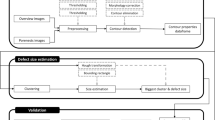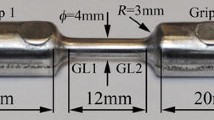Abstract
A FLUENT™-based thermal-fluid-compositional model has been developed and applied to a low-pressure, die-cast, A356 aluminum alloy wheel to explore the effects of macro-segregation of hydrogen and late-stage liquid encapsulation on pore formation during solidification. Based on the evolution of temperature, pressure, and hydrogen concentration in the liquid output from FLUENT, the porosity size distribution has been predicted at a number of locations in a commercially produced wheel using an in-house micro-porosity model. The porosity model incorporates pore nucleation kinetics based on hydrogen supersaturation, and two modes of pore growth: the first, occurring at low solid fractions is based on hydrogen diffusion; and the second, occurring at high solid fractions is based on conservation of volume. Samples from a commercially cast wheel have been analyzed using X-ray micro-tomography to provide basic validation of the micro-porosity model. The predicted results showed that the evolution in pressure has the dominant effect on pore growth, but only under conditions where pores have nucleated prior to late-stage liquid encapsulation. Otherwise, the cooling rate appears to have the dominant effect. The accuracy of the model is discussed in terms of the predicted pore size distribution and number density of pores. Areas for continued development are presented.











Similar content being viewed by others
References
B. Zhang, S.L. Cockcroft, D.M. Maijer, J.D. Zhu, and A.B. Phillion: JOM, 2005, vol. 57, pp. 36–43.
P.D. Lee, A. Chirazi, and D. See: J. Light Met., 2001, vol. 1, pp. 15–30.
J.D. Zhu, S.L. Cockcroft, and D.M. Maijer: Metall. Mater. Trans. A, 2006, vol. 37A, pp. 1075–85.
G. Backer and Q.G. Wang: Metall. Mater. Trans. B, 2007, vol. 38, pp. 533–40.
L. Yao, S. Cockcroft, J. Zhu, and C. Reilly: Metall. Mater. Trans. A, 2011, vol. 42, pp. 4137–48.
C. Puncreobutr, P.D. Lee, R.W. Hamilton, and A.B. Phillion: JOM, 2012, vol. 64, pp. 89–95.
A. Bahmani, N. Hatami, and N. Varahram: Int J Adv Manuf Technol, 2013, vol. 64, pp. 1313–21.
T. Wang, D. AN, Q. Zhang, and M. Zhu: in IOP Conf. Series: Materials Science and Engineering, 2015.
V.R. Voller, A.D. Brent, and C. Prakash: Int. J. Heat Mass Transf., 1989, vol. 32, pp. 1719–31.
C. Beckermann: Int. Mater. Rev., 2002, vol. 47, pp. 243–61.
M. Ghods, L. Johnson, M. Lauer, R.N. Grugel, S.N. Tewari, and D.R. Poirier: J. Cryst. Growth, 2016, vol. 449, pp. 134–47.
P. Fan, S. Cockcroft, D. Maijer, L. Yao, C. Reilly, and A. Phillion: Metals (Basel)., 2018, vol. 8, pp. 503–16.
P.N. Anyalebechi: Scr. Metall. Mater., 1995, vol. 33, pp. 1209–16.
K.D. Carlson, Z. Lin, and C. Beckermann: Metall. Mater. Trans. B, 2007, vol. 38, pp. 541–55.
L. Yao, S. Cockcroft, C. Reilly, and J. Zhu: Metall. Mater. Trans. A, 2011, vol. 43, pp. 1004–16.
Acknowledgments
The authors gratefully acknowledge the financial support of the NSERC, under the Automotive Partnership Canada Program. ABP acknowledges use of the facilities and support provided by the Research Complex at Harwell, funded in part by the EPSRC (EP/I02249X/1 and EP/M009688/1).
Author information
Authors and Affiliations
Corresponding author
Additional information
Publisher's Note
Springer Nature remains neutral with regard to jurisdictional claims in published maps and institutional affiliations.
FLUENT is a trademark of Ansys. Inc., Canonsburg, PA, United States.
Manuscript submitted March 3, 2019.
Rights and permissions
About this article
Cite this article
Fan, P., Cockcroft, S.L., Maijer, D.M. et al. Porosity Prediction in A356 Wheel Casting. Metall Mater Trans B 50, 2421–2435 (2019). https://doi.org/10.1007/s11663-019-01642-9
Received:
Published:
Issue Date:
DOI: https://doi.org/10.1007/s11663-019-01642-9




